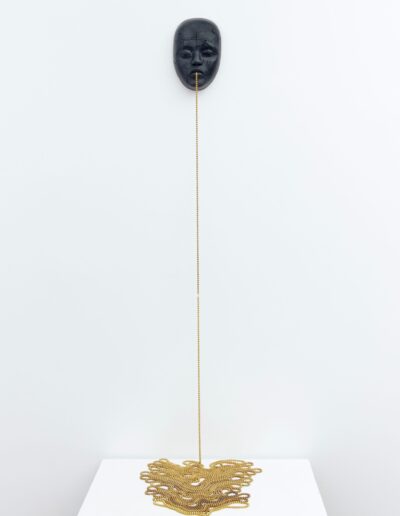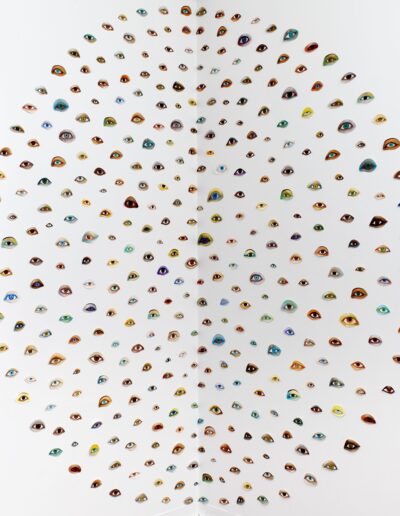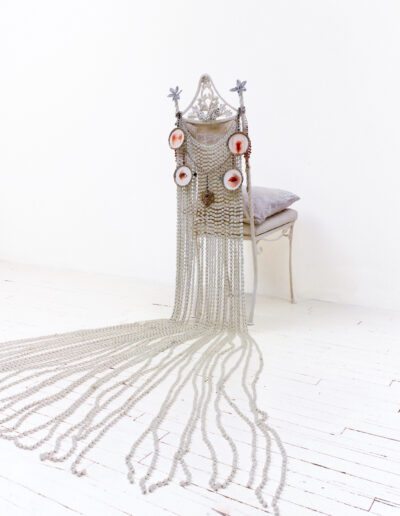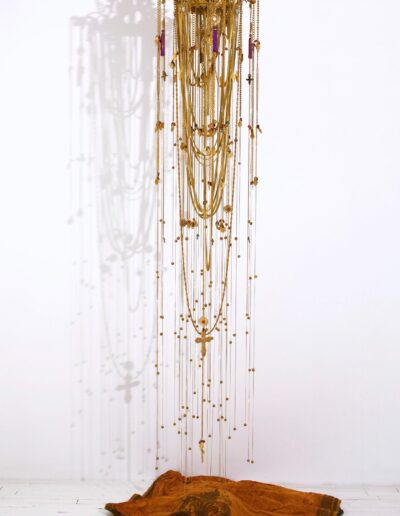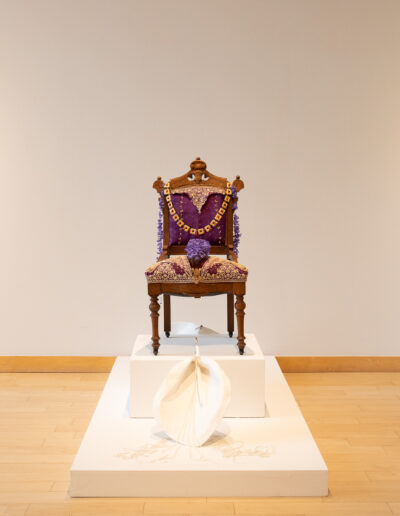In conjunction with the 42nd anniversary Tri-State Sculpture Conference, the Turchin Center for the Visual Arts is proud to partner with the 2020 Conference Chair, Travis Donovan, assistant professor of sculpture, Department of Art in Appalachian State University’s College of Fine and Applied Arts to host the conference and bring the award-winning sculptor, Esperanza Cortés to campus as a keynote speaker and guest artist for an exhibition, CANTAR DE CIEGOS/SONG OF THE BLIND, in the Turchin Center’s Mayer Gallery. Tri-State Sculptors is an association of education sculptors in the Virginia, North Carolina and South Carolina areas.
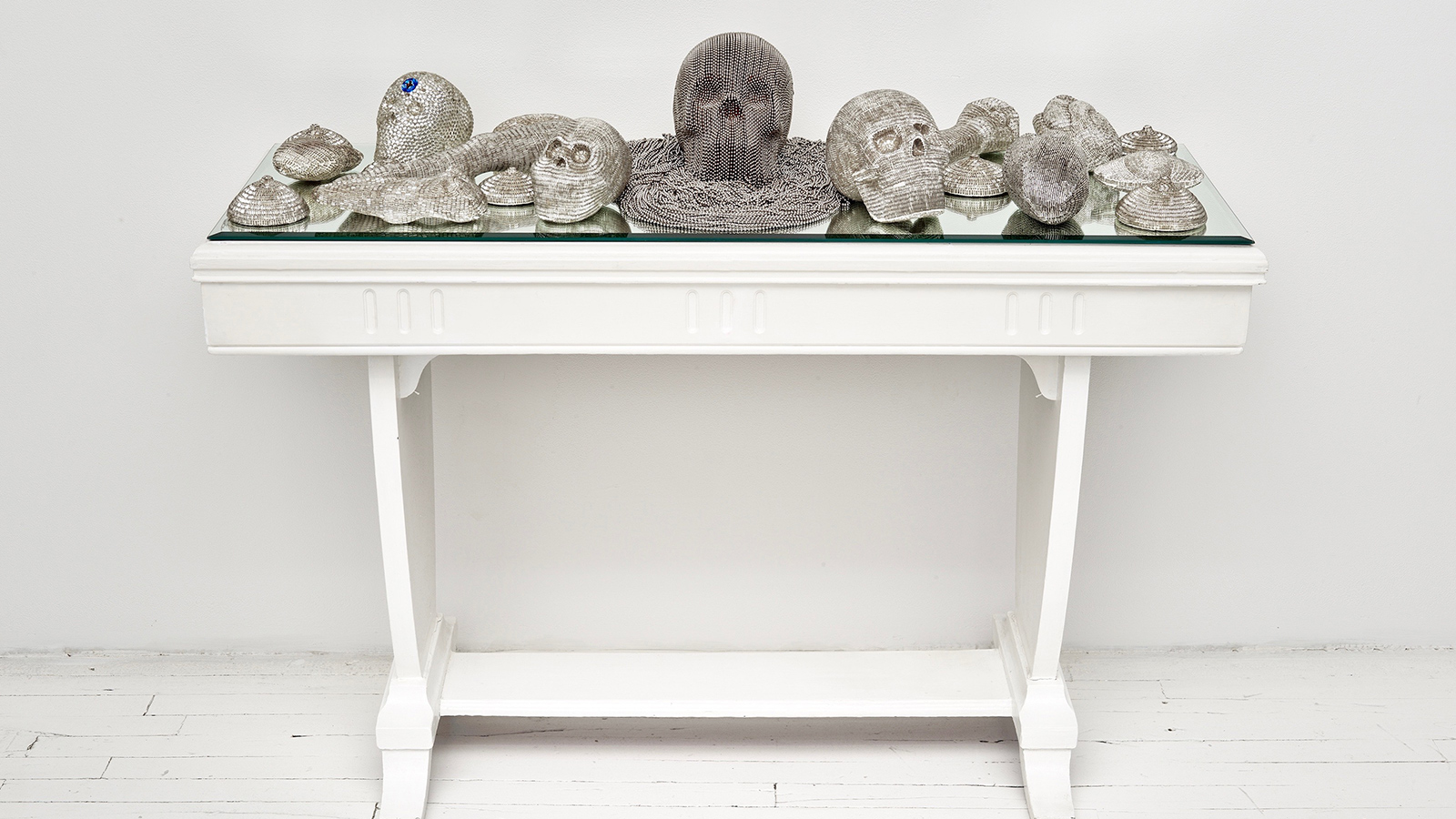
Esperanza Cortés; SECOND SIGHT; 2008 – 2018; 20 clay sculptures, glass beads, mirror, table. Second Sight honors the Curandera (healer) in Latinx culture as a whole, as well as the personal connection to my grandmothers who were both curanderas in Colombia. These individuals dedicated their lives to maintaining the physical and spiritual well being and equilibrium of their families and communities. Each individual piece represents the instruments and fruits of their Labors.
Esperanza Cortés; LA DORADA; 2017; clay sculpture, gold beads 60”L x 18” W x 5” D. La Dorada addresses the dilemma of the artisanal gold miners in Colombia, many who are women that say that they have been mining since they were in their mothers bellies. These miners are in jeopardy of losing the mining rights to the land on which their families have lived and worked for 400 years.
Esperanza Cortés; OJO II; 2017; Installation of 500 handprinted eye portraits, watercolor and gouache on paper, 130” diameter. Ojo II explores the human response to political, economic, natural disasters and human rights abuses. There are those who watch and those who are watched.
Esperanza Cortés; CHARMED LIFE; 2008 – 2012; Frescoes, chair, alabaster beads, glass beads, amulets, chains, brocade; 7’ L x 7’ W x 4’ H. The installation considers the physical/social/spiritual sacrifices made to conform. Bruises, lacerations, and contusions stand for the abuses imposed by self and others and question the lengths traversed to attain our desires and the desires themselves. What is exchange for life lived as a fairy tale?
Esperanza Cortés; EMPIRE; 2016; Chandelier, gold leaf, 1000 feet of gold plated jewelry chain, gold plated metal leaves, brass beads, glass beads; 18′ L x 6′ Diameter. The history of colonial empire is the history of the Americas, specially places like my birthplace Colombia.
Artist statement
“My interest in the folk-art traditions, art rituals, music and dance of Latin America, The Caribbean and Africa, and their continuous and evolving changes are at the core of my practice. I utilize a wide variety of materials and artistic methods often in combination with reworked found objects that are impregnated with cultural symbols that act as sites of memory. The hand-crafted artworks which are poetically and intricately crafted create an intimate repository for individual and collective memory and implement the human body as a symbol and expression of nature, vulnerability and power.
“Physicality informs my practice through body memory. As a former Afro-Latin dancer, my work seeks to underscore and use sacred space and the patterns of dance and percussion. I use music and fragments of histories as departure points to investigate and build the structure and space of the installations. My artworks are organic and improvisational constructions that are infused with hope and renewal.
“Esperanza (hope) is a guiding force in the making of my work, which is a call and response to people, culture, place and history. My installations which are organic and improvisational constructions are infused with hope and renewal.
“As a multidisciplinary artist, I create sculptures, installations, reliefs, works on paper and site-specific outdoor interventions. I use my work to encourage viewers to reconsider social and historical narratives especially when dealing with Colonialism, and raises critical questions about the politics of erasure and exclusion. My recent work examines the extent to which a consciousness, national or personal, defines itself through the opposing force of a transcultural experience. My work is an exercise of collective memory that underscores its transformative potential and triggers a reflection of issues of interpretation, dialogue, and the role of contemporary culture in our global reality. I create structures for collaborative dialogues as expressions of personal, community truths and histories.”
— Esperanza Cortés
About the artist
Esperanza Cortés is a Colombian born contemporary multidisciplinary artist based in New York City. Cortés has exhibited in the United States in solo and group exhibitions in venues including Smack Mellon Gallery, Neuberger Museum of Art, Bronx Museum of Art, Queens Museum, El Museo Del Barrio, MoMA PS1, Socrates Sculpture Park and White-box Gallery in New York City. Nationally Cortes exhibitions include Cleveland Art Museum, OH, CSU Galleries at Cleveland University, OH, Helen Day Art Center, VT and The Lorenzo Homar Gallery, PA. Internationally, exhibitions include Germany, Hungary, Slovakia, Poland, Japan, Mexico, Colombia, Dominican Republic, Spain and Greece.
Esperanza Cortés is a recipient of awards including: The John Simon Guggenheim Memorial Fellowship: BRIC Media Arts Fellowship: Lower Manhattan Cultural Council Creative Engagement Grant: Joan Mitchell Foundation Painters & Sculptors Grant: U.S. DEPARTMENT OF STATE: Art in Embassies Program: Puffin Foundation Project Grant: Bronx Museum of the Art, AIM Program: New York State Biennial: Robert Rauchenberg Foundation, Change Grant: New York Foundation for the Arts: Sustained Achievement in the Visual Arts Award.
Esperanza Cortés is a recipient of residencies including: McColl Center for Arts + Innovation: Museum of Arts and Design Artist Studio Residency: BRIC Workspace Program: The Caldera Residency: Joan Mitchell Center: Webb School of Knoxville: Sculpture Space: Fountainhead Residency: MoMA PS1 International Residency Program: Socrates Sculpture Park: Abrons Art Center: Longwood Art Project. Esperanza’s international residencies include Altos de Chavon, Dominican Republic, Can Serrat, Spain, and Bielska BWA Gallery, Poland.
Her work has been reviewed by Whitehot, Artforum, Artnews, New York Times, New Art Examiner, Art in America and Art Nexus. Esperanza has been the subject of interviews and programs on public television and radio, Newspapers, Art blogs, and publications in the USA, Europe, South America and the Caribbean.
Esperanza Cortés has designed workshops and taught extensively as a museum educator, artist in residence and community artist, creating murals, sculptures, site specific installations and visual arts projects through The Lower Manhattan Cultural Council, Artist Space, Brooklyn’s Children’s Museum, Socrates Sculpture Park, El Museo Del Barrio, Museum of Modern Art, Whitney Museum of Art and the Museum of Art and Design. Cortés’s work is in private and public collections including the American Embassy in Monterey, Mexico.
Additional resources
- Flickr – Installation images
-
Esperanza Cortés – Official website.
-
Esperanza Cortés – Page published by John Simon Guggenheim Memorial Foundation.
-
Esperanza Cortés – Page published by U.S. Department of State.
-
Esperanza Cortés – Page published by Sculpture Space.
-
Esperanza Cortés – Page published by Socrates Sculpture Park.

